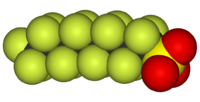
Photo from wikipedia
Abstract Boron (B) is an essential micronutrient, crucial for the growth and development of crop plants. However, the essential to a toxic range of B in the plant is exceptionally… Click to show full abstract
Abstract Boron (B) is an essential micronutrient, crucial for the growth and development of crop plants. However, the essential to a toxic range of B in the plant is exceptionally narrow, and symptoms develop with a slight change in its concentration in soil. The morphological and anatomical response, such as leaf chlorosis, stunted growth, and impairment in the xylem and phloem development occurs under B-toxicity. The transport of B in the plant occurs via transpiration stream with the involvement of B-channels and transporter in the roots. The higher accumulation of B in source and sink tissue tends to have lower photosynthetic, chlorophyll content, infertility, failure of pollen tube formation and germination, impairment of cell wall formation, and disruption of membrane systems. Excess B in the plant hinders the uptake of other micronutrients, hormone transport, and metabolite partitioning. B-mediated reactive oxygen species production leads to the synthesis of antioxidant enzymes which help to scavenge these molecules and prevent the plant from further oxidative damage. This review highlights morpho-anatomical, physiological, biochemical, and molecular responses of the plant under B toxicity and thereby might help the researchers to understand the related mechanism and design strategies to develop B tolerant cultivars. Graphical Abstract NOVELTY STATEMENT The physio-biochemical and molecular responses and mechanism of B uptake under its toxic condition have been illustrated. The spatial distribution of boron under its toxic condition and its accumulation in the plant might be regulated with sugar alcohols (polyols). This review throws light on the elevated level of B in the soil-plant system and provides management strategies for alleviating B toxicity in the plant.
Journal Title: International Journal of Phytoremediation
Year Published: 2022
Link to full text (if available)
Share on Social Media: Sign Up to like & get
recommendations!